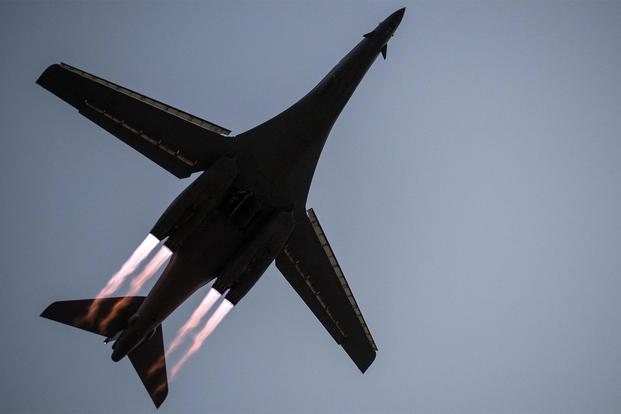The Air Force has resumed flights of the B-1B Lancer bomber after a nearly month-long stand-down of the fleet.
Air Force Global Strike officials on Tuesday said that the heavy bombers resumed flight operations this week following the safety inspection stand-down, which was ordered March 28 and marked the second fleetwide halt in operations in about a year.
"Individual B-1B aircraft will return to flight as the inspections and maintenance directed during the stand-down are completed on each aircraft," the command said in a news release.
"We are proud of the tremendous efforts of our maintainers and aircrew flight equipment technicians in identifying, inspecting and remediating any potential issues with the B-1B egress system," said Maj. Gen. James Dawkins Jr., 8th Air Force commander, who is responsible for the Air Force bomber force. "The aircraft are still safe to fly, and we are confident that this stand-down has resulted in increased safety within the B-1B fleet."
Related content:
- Anatomy of a B-1 Bomber Training Mission
- Overtasking of B-1 Lancer Fleet Led to Faster Deterioration, General Says
- For B-1s and B-2s, Fending Off Retirement in Reserves Would Be Pricey
Last week, AFGSC commander Gen. Tim Ray told reporters that inspections were ongoing after airmen found a rigged "drogue chute" incorrectly installed in the ejection seat egress system, a problem that might affect the rest of the fleet.
"A drogue shoot 'rights' an ejection seat when it departs ... and I didn't like what I saw," Ray said, citing his reasoning for the precautionary safety inspections.
The issue is "part of the egress system," the way airmen exit the bomber in an emergency.
Ray said his immediate concern was for the aircrews' safety.
"I don't care how bad the readiness is, your personal safety is more important," he said April 17.
The B-1 has experienced three setback "events" in about a year's time, Ray said, referring to an emergency landing incident related to an ejection-seat issue and two fleetwide groundings, including the most recent one.
In addition to the recent halt in operations, the command grounded the fleet over safety concerns last year, a problem also related to the Lancer's ejection seats. Officials ordered a stand-down on June 7, 2018, which lasted three weeks while the fleet was inspected.
That stand-down was the direct result of an emergency landing made by a Dyess Air Force Base, Texas-based B-1 on May 1, 2018, at Midland Airport in Texas. Air Force Secretary Heather Wilson confirmed speculation at the time that the B-1 had to make an emergency landing after an ejection seat didn't blow during an earlier in-flight problem.
Months after that incident, UTC Aerospace Systems, manufacturer of the bomber's ACES II ejection seat, said the seat itself is not the problem, but rather the sequence system.
The most recent ejection issue does not appear to be related to the issues that occurred last year, AFGSC has said.
"The most recent inspections have aircrew examining roughly three aircraft a week at Dyess and two a week at Ellsworth Air Force Base, South Dakota," Ray said last week.
The Air Force has 62 Lancers in its fleet. It plans to retire the bombers in 2036.
Related Video:
Bullet Points: B-1B Lancer
-- Oriana Pawlyk can be reached at oriana.pawlyk@military.com. Follow her on Twitter at @Oriana0214.












